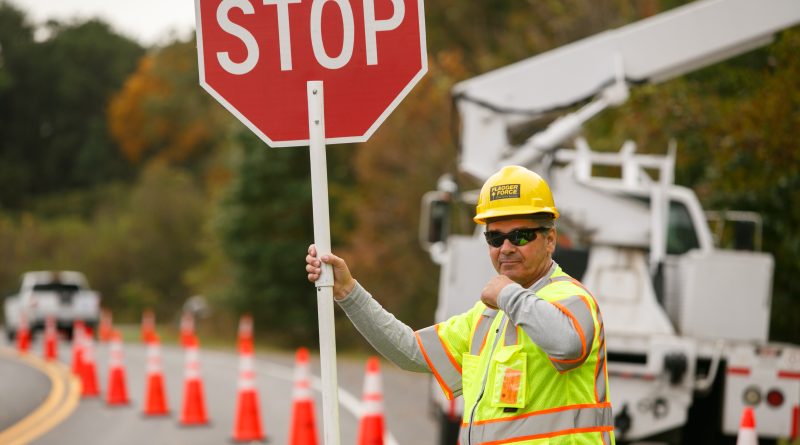Motorists Play a Critical Role in Keeping Traffic Control Professionals Safe
Traffic control professionals play a critical role in maintaining our nation’s infrastructure. They work on the frontline to protect important construction and utility personnel and ensure motorists travel safely through work zones.
Working on or near roadways has inherent risks such as speeding vehicles and distracted drivers. In 2020, 857 people were tragically killed, and 44,240 people were injured in work zone crashes, according to the National Safety Council. The number of lives impacted by these incidents demonstrates the need for safer work zones.
From Monday, April 17 to Friday, April 21, state and private organizations will observe National Work Zone Awareness Week (NWZAW), an annual campaign held at the start of the construction season to encourage community members to use extra caution while navigating work zones. The observance is an important opportunity to amplify efforts to increase awareness and educate the public on their role in keeping our nation’s roadways safe and moving.
As the vice president of risk and safety at Flagger Force, an industry-leading, Safety-Driven®, short-term traffic control company serving the eastern United States, I have seen firsthand the benefits gained when safety professionals empower and educate community members on how to safely navigate work zones. In honor of NWZAW and the increase in construction work on roadways around the nation during the spring and summer, I would like to reinforce the critical role motorists play in keeping themselves and traffic control professionals safe and offer tips that motorists can implement when they encounter work zones.
Avoid Distractions
In 2021, there was a 12% rise in fatal crashes involving at least one distracted driver, according to the National Highway Traffic Safety Administration. Distracted driving is one of the leading causes of work zone accidents. Whether motorists are texting, talking on the phone, changing the music, eating, or talking to passengers, any action that takes their attention away from the road is dangerous. Many work zone accidents occur because drivers are not paying attention and miss all the warning signs for the approaching work zone until it is too late.
Slow Down
Speed is another contributing factor to work zone injuries and fatalities. In 2020, 37% of fatal work zone crashes involved a speeding vehicle, according to the U.S. Department of Transportation Federal Highway Association. When motorists exceed the posted speed limit in a work zone, they are putting both themselves and traffic control professionals at risk. I encourage motorists to be cognizant of the speed limit and slow down as they move into, through, and out of work zones.
Don’t Drive Drowsy or Impaired
Fatalities involving alcohol-impaired driving were up 14% in 2021, according to the National Highway Traffic Safety Administration. When traffic control professionals are actively setting up a work zone, flagging, or breaking down a work zone, drowsy drivers or those under the influence who may erroneously enter the work area pose a significant risk. Additionally, driving while drowsy or impaired slows down an individual’s ability to react to traffic control professionals’ signals and roadway changes. With the number of rideshare apps available to consumers, I encourage community members never to drive while fatigued or under the influence because it puts multiple lives at risk.
Be Patient
I understand that encountering work zones can slow down motorists and may seem like an inconvenience. But it is important individuals remain calm and patient. Traffic control professionals are doing their job and want to keep everyone safe. Becoming frustrated or impatient will only make the situation worse and could put your safety, as well as the safety of roadway workers, at risk.
As we strive to raise awareness about the importance of safe driving practices in work zones, we remember and reflect on all the lives that have been tragically lost in work zone accidents this year. Let’s work together as a community to create safer roadways and ensure everyone gets home to their families each day!

Luke Lazar, CSP, is the vice president of risk and safety at Flagger Force. With close to 30 years of safety consulting experience throughout various industries and companies, he is a certified safety professional (CSP) with the Board of Certified Safety Professionals. In his current role, he strategizes the policies and practices of the company to ensure all employees and clients are safe on the job site or at the office. He oversees a team of safety professionals throughout the eastern United States with a range of skills and experiences, coaching and mentoring individuals to prevent incidents. Lazar also manages the training programs within the Flagger Force Academy for new and current field employees. While continuously advancing the safety culture of Flagger Force, his future vision for the risk department is focused on three things: being present, being proactive, and being predictive. Lazar received his bachelor’s degree in occupational safety and health from Millersville University of Pennsylvania and is an active member of the American Society of Safety Engineers (ASSE).

